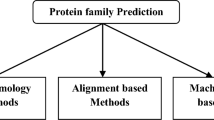Abstract
Ammonium is an excellent nitrogen source, and ammonium transfer is a fundamental process in most organisms. Membrane transport of ammonium is the key component of nitrogen metabolism mediated by Ammonium Transporter/Methylamine Permease/Rhesus (AMT/MEP/Rh) protein family. Ammonium transporters play different physiological roles in various organisms. Here, we looked at the protein characteristics of ammonium transporters in different organisms to create a link between protein characteristics and the organism. In order to increase the accuracy and precision of the employed models, for the first time, an attempt was made to cover all structural aspects of ammonium transporters in animals, bacteria, fungi, plants, and human by extracting and calculating 874 protein attributes of primary, secondary, and tertiary structures for each ammonium transporter. Then, various weighting and modeling algorithms were applied to determine how structural protein features change between organisms. Considering a large number of protein attributes made it possible to detect key protein characteristics in the structure of ammonium transporters. The results, for the first time, indicated that His-based features including count/frequency of His and frequency/count of Ile-His were the most significant features generating different types of ammonium transporters within organisms. Within different tested models, the C5.0 model was the most efficient and precise model for discrimination of organism type, based on ammonium transporter sequence, with the precision of 94.85%. The determination of protein characteristics of ammonium transporters in different organisms provides a new vista for understanding the evolution of transporters based on the modulation of protein characteristics and facilitates engineering of new transporters. In our point of view, dissecting a large number of structural protein characteristics through data mining algorithms provides a novel functional strategy for studying evolution and phylogeny. This research will serve as a basis for future studies on engineering novel ammonium transporters.
Similar content being viewed by others
References
Andrade SL and Einsle O (2007) The Amt/Mep/Rh family of ammonium transport proteins. Mol. Membr. Biol. 24: 357–365.
Ashrafi E, Alemzadeh A, Ebrahimi M, Ebrahimie E and Dadkhodaei N (2011) Amino Acid Features of P1B-ATPase Heavy Metal Transporters Enabling Small Numbers of Organisms to Cope with Heavy Metal Pollution. Bioinform. Biol. Insights 5: 59–82.
Benjelloun F, Bakouh N, Fritsch J, Hulin P, Lipecka J, Edelman A, Planelles G, Thomas SR and Cherif-Zahar B (2005) Expression of the human erythroid Rh glycoprotein (RhAG) enhances both NH3 and NH4+ transport in HeLa cells. Pflugers Arch. 450: 155–167.
Bijanzadeh E, Emam Y and Ebrahimie E (2010) Determining the most important features contributing to wheat grain yield using supervised feature selection model. Aust. J. Crop Sci. 4: 402–407.
Bostick DL and Brooks CL (2007) Deprotonation by dehydration: the origin of ammonium sensing in the AmtB channel. PLoS Comput. Biol. 3: e22.
Dancey D, Bandar ZA and McLean D (2007) Logistic model tree extraction from artificial neural networks. IEEE Trans. Syst. Man Cybern. Part B-Cybern. 37: 794–802.
Ebrahimi M, Ebrahimi E and Ebrahimi M (2009) Searching for patterns of thermostability in proteins and defining the main features contributing to enzyme thermostability through screening, clustering, and decision tree algorithms. EXCLI J. 8: 218–233.
Ebrahimi M and Ebrahimie E (2010) Sequence-based prediction of enzyme thermostability through bioinformatics algorithms. Curr. Bioinform. 5: 195–203
Ebrahimi M, Ebrahimie E, Shamabadi N and Ebrahimi M (2010) Are there any differences between features of proteins expressed in malignant and benign breast cancers? JRMS 15: 299–309.
Ebrahimie E, Ebrahimi M and Rahpayma M (2010) Investigating protein features contribute to salt stability of halolysin proteins. J. Cell Mol. Res. 2: 15–28.
Ebrahimie E, Ebrahimi M and Rahpayma Sarvestani N (2011) Protein attributes contribute to halo-stability, bioinformatics approach. Saline Syst. 7: 1.
Enkavi G and Tajkhorshid E (2010) Simulation of spontaneous substrate binding revealing the binding pathway and mechanism and initial conformational response of GlpT. Biochemistry 49: 1105–1114.
Fernandez E and Galvan A (2007) Inorganic nitrogen assimilation in Chlamydomonas. J. exp. bot. 58: 2279–2287.
Glass AD, Britto DT, Kaiser BN, Kinghorn JR, Kronzucker HJ, Kumar A, Okamoto M, Rawat S, Siddiqi MY, Unkles SE and Vidmar JJ (2002) The regulation of nitrate and ammonium transport systems in plants. J. exp. bot. 53: 855–864.
Gromiha MM (2007) Prediction of protein stability upon point mutations. Biochem. Soc. Trans. 35: 1569–1573.
Howitt SMU and dvardi MK (2000) Structure, function and regulation of ammonium transporters in plants. BBA 1465: 152–170.
Hsiao YY, Van RC, Hung SH, Lin HH and Pan RL (2004) Roles of histidine residues in plant vacuolar H(+)-pyrophosphatase. BBA 1608: 190–199.
Li XD, Lupo D, Zheng L and Winkler F (2006) Structural and functional insights into the AmtB/Mep/Rh protein family. Transfus. Clin. Biol. 13: 65–69.
Loque D and Wiren N (2004) Regulatory levels for the transport of ammonium in plant roots. J. exp. bot. 55: 1293–1305
Ludewig U, Neuhauser B and Dynowski M (2007) Molecular mechanisms of ammonium transport and accumulation in plants. FEBS lett. 581: 2301–2308
Lupo D, Li XD, Durand A, Tomizaki T, Cherif-Zahar B, Matassi G, Merrick M and Winkler FK (2007) The 1.3-A resolution structure of Nitrosomonas europaea Rh50 and mechanistic implications for NH3 transport by Rhesus family proteins. Proc. Natl. Acad. Sci. U. S. A. 104: 19303–19308.
Luzhkov VB, Almlof M, Nervall M and Aqvist J (2006) Computational study of the binding affinity and selectivity of the bacterial ammonium transporter AmtB. Biochemistry 45: 10807–10814.
Mayer M, Dynowski M and Ludewig U (2006) Ammonium ion transport by the AMT/Rh homologue LeAMT1;1. Biochem. J. 396: 431–437.
Mayer M and Ludewig U (2006) Role of AMT1;1 in NH4+ acquisition in Arabidopsis thaliana. Plant biol. 8: 522–528.
Navarre C, Degand H, Bennett KL, Crawford JS, Mortz E and Boutry M (2002) Subproteomics: identification of plasma membrane proteins from the yeast Saccharomyces cerevisiae. Proteomics 2: 1706–1714.
Simon-Rosin U, Wood C and Udvardi MK (2003) Molecular and cellular characterisation of LjAMT2;1, an ammonium transporter from the model legume Lotus japonicus. Plant Mol.Biol. 51: 99–108.
Sogaard R, Alsterfjord M, Macaulay N and Zeuthen T (2009) Ammonium ion transport by the AMT/Rh homolog TaAMT1;1 is stimulated by acidic pH. Pflugers. Arch. 458: 733–743.
Sohlenkamp C, Wood CC, Roeb GW and Udvardi MK (2002) Characterization of Arabidopsis AtAMT2, a high-affinity ammonium transporter of the plasma membrane. Plant physiol. 130: 1788–1796.
von Wiren N, Gazzarrini S, Gojon A and Frommer WB (2000) The molecular physiology of ammonium uptake and retrieval. Curr. Opin. Plant Biol. 3: 254–261.
Williams L Miller A (2001) Transporters Responsible for the Uptake and Partitioning of Nitrogenous Solutes. Annu. Rev. Plant Physiol. Plant Mol. Biol. 52: 659–688
Winkler FK (2006) Amt/MEP/Rh proteins conduct ammonia. Pflugers Arch. 451: 701–707.
Wu X, Prasad PD, Leibach FH and Ganapathy V (1998) cDNA sequence, transport function, and genomic organization of human OCTN2, a new member of the organic cation transporter family. Biochem. Biophys. Res. Commun. 246: 589–595.
Yuan L, Graff L, Loque D, Kojima S, Tsuchiya YN, Takahashi H and von Wiren N (2009) AtAMT1;4, a pollen-specific high-affinity ammonium transporter of the plasma membrane in Arabidopsis. Plant Cell Physiol. 50: 13–25.
Author information
Authors and Affiliations
Corresponding author
Rights and permissions
About this article
Cite this article
Tahrokh, E., Ebrahimi, M., Ebrahimi, M. et al. Comparative study of ammonium transporters in different organisms by study of a large number of structural protein features via data mining algorithms. Genes Genom 33, 565–575 (2011). https://doi.org/10.1007/s13258-011-0057-6
Received:
Accepted:
Published:
Issue Date:
DOI: https://doi.org/10.1007/s13258-011-0057-6




